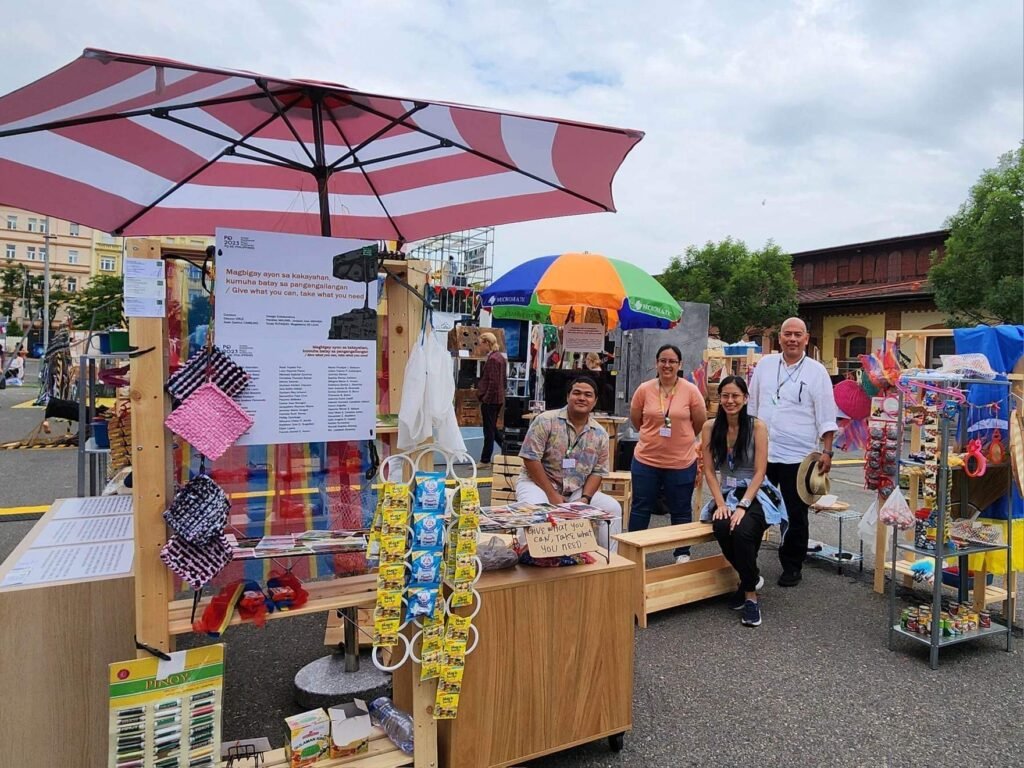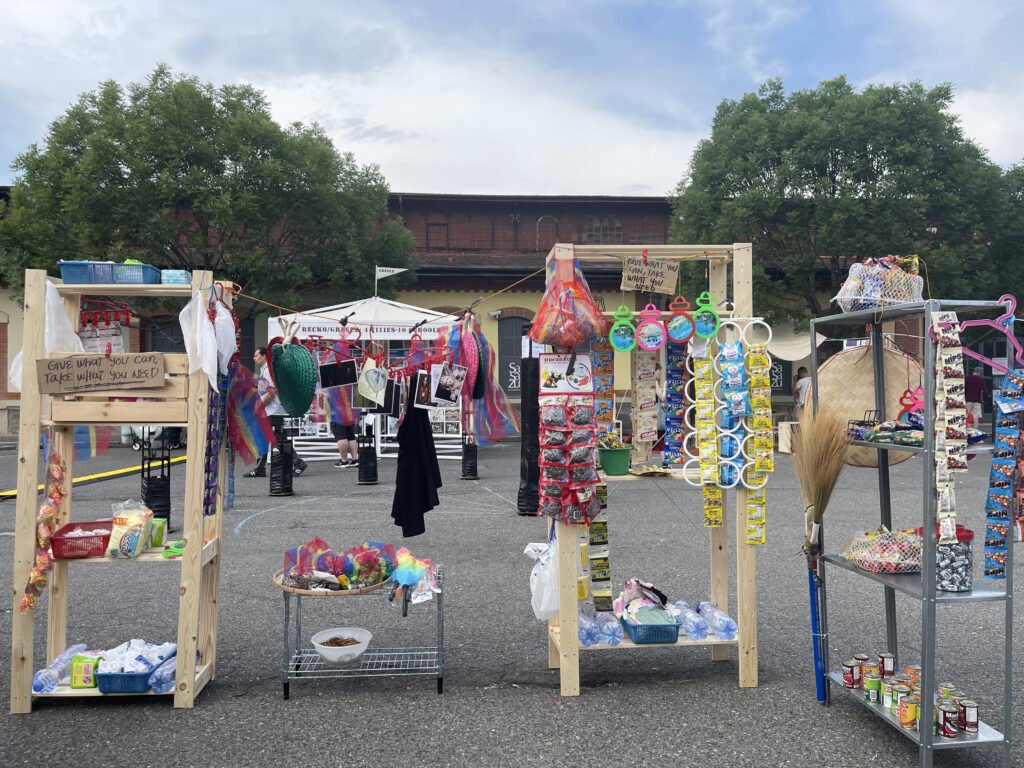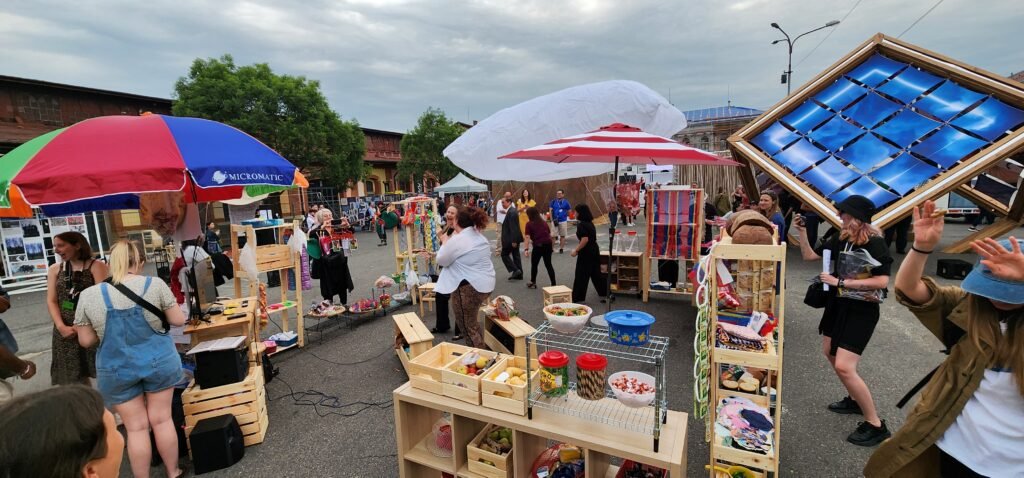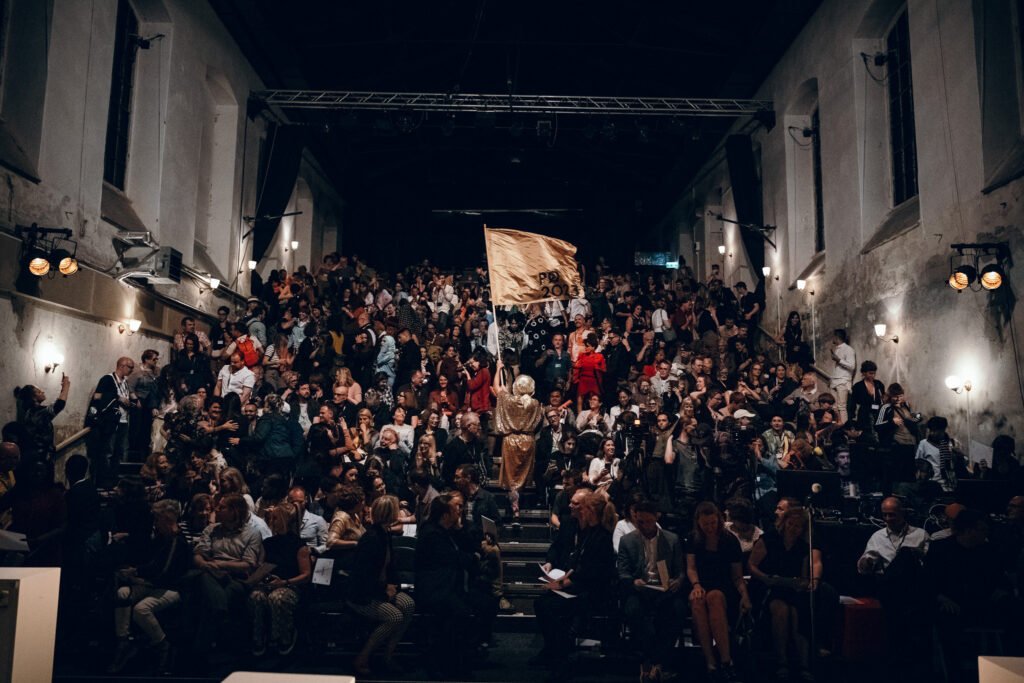Introduction and Interview Gabrielle de la Cruz
Images Alain Zedrick Camiling and Prague Quadrennial 2023
‘Magbigay ayon sa kakayahan, kumuha batay sa pangangailangan’ (Give what you can, take what you need) is the title of the Philippines’ sole and official entry under the Student Exhibition Category of the 2023 Prague Quadrennial. The phrase is derived from the concept of a community pantry, an initiative led by Ana Patricia Non during the onslaught of the COVID-19 pandemic in the country. “The Philippine entry is a (literal) community pantry installation,” says the team of student artists from the De La Salle College of Saint Benilde. Stacks of shelves hold items that one would often find in a typical sari-sari store, with the entire setup incorporated with Filipino touches such as a karaoke system and the instantly recognizable colorful Filipino umbrella.
The theme of this year’s Prague Quadrennial is RARE: “art springing out of new ideas, materials, artistic approaches, and design practices that connect to the human level from within your environment, with its genius loci and unique situation.” Philippine entry curators Alain Zedrick Camiling and Ellawyn Cruz share that the use of the concept of a community pantry for both the installation’s form and meaning allowed them to showcase the resiliency, resourcefulness, and heart of the Filipino community.
Below is our chat with Camiling and Cruz where they share some of their memories and learnings from the experience and what this win means for the Filipino creative community:


Congratulations Alain, Ellawyn, and the entire team! How are you? Can you walk us through your entire 2023 Prague Quadrennial journey?
Thank you, Kanto! We are both very grateful for the entire experience. The planning took approximately 3 months including the actual quadrennial participation. The team arrived in Prague three days before the opening, but the total days for installation were only two days. On the day of our arrival, we rushed to procure the furniture and fixtures we need for the actual space. This also included some local produce which is more embedded in Czech culture.
The weather during the quadrennial was very unpredictable. As curators of the exhibition, we have been persistently recalibrating what would work best. It took us a lot of time assembling and reinstalling each day as there was so much rain. There were times we were actually wearing ponchos while dismantling the exhibit before going home. It was very challenging as we were only working with 2 design collaborators in the set-up.
The first day was overwhelming because the exhibits on site evidently had many resources and manpower. In terms of scale, we’d say that ours was less complex in terms of design and construction. We’ve maximized the space allotted by putting up a perimeter through shelves and racks. Some components of the initial plan changed a bit due to the availability of these shelves and racks in Prague.


You say that you used available shelves and racks in Prague. Can you tell us more about the materials that you brought all the way from the Philippines? Where did you source them and how did you select them?
Honestly, most of the items were procured from Divisoria by the team. Some items like food products and toiletries in sachets were bought from a wholesale store in Malate. Our primary consideration is that all the products to be showcased must be locally sourced from the Philippines. Otherwise, the community pantry isn’t Filipino at all. We attempted to mirror the products that you usually see in community pantries and sari-sari stores such as small chips, candies, food items in tetra packs, and the usual Filipino tingi items.
The exhibition centers on the concept of a community pantry, a movement led by Ana Patricia Non. Did you consult with her about this project? What were her thoughts?
Yes, we did reach out to Patricia. She was happy about it and told us that it is a big success and an opportunity to represent our culture, including our struggles. We have been in touch with her and the Community Pantry PH team to possibly organize a public program where they could share their experiences in spearheading the initiative. We will surely keep everyone posted about it!
We would say that the general experience was meaningful despite many constraints Through the exhibition, we’ve met a lot of people from diverse parts of the world. Interestingly, we’ve also spoken to some individuals who have had struggles during the pandemic. This actually points out to the award we received, Intercultural Exchange Award. The exhibition space served as a potent avenue for relief, exchange, and belongingness.


You say that the space served as an avenue for exchange and belongingness. What were some of the interesting insights or anecdotes that you gathered from visitors or guests?
The exhibition replicated a sala and a karaoke area both positioned at the center of the pantry. One very common insight we’ve heard includes how they are amazed by such an initiative started by Patricia Non. We think that the exhibition was able to show how resilient, resourceful, and big-hearted Filipinos are to their neighbors, despite having little to no support from the government during the pandemic.
In relation to the award received, we think we were able to transcend how ‘holding a space for one another in a world that’s in desperate need of compassion’ should prevail in times we need it most. There was one afternoon when it rained so hard while we were having lunch at a nearby restaurant and thought that there was nothing we can do if we rushed ourselves to fix it. Upon returning to the exhibition, we saw that our pantry was well-covered and packed-up by our neighboring exhibitors. It was a teary-eyed moment for all of us! Right there, we were sure that we were able to transcend what the exhibition is about – mutual care, reflecting pakikipagkapwa and bayanihan.


You obviously went through difficulties due to the weather! But thanks to the kind-hearted exhibitors who safeguarded the installation. Were there any other challenges? How did you address them?
Yes, the weather conditions were unexpected. We literally brought summer clothes! Looking back, we do wish we could have worked on something to address the installation’s structural stability and for it to be less labor extensive.
In terms of collaboration, we approached the project as something open and generative. We acknowledged factors that actively shape how the project is approached—from suppliers and support all the way to the actual space. Both of us have been actively consulting each other and our design collaborators during the installation. We actually never thought about getting an award, because we were just so focused on how to get through each day.
As curators, we learned that interactive exhibition-making is a potent strategy to assimilate the concept of mutual aid among its global audiences and participants through atmospherics; curated spaces are inherent routes for intercultural exchange, diplomacy, and social solidarity; and scenography and curation are interrelated artistic and creative practices involving collaboration, care, and process.


Now that the exhibit is over and you have brought home an award, what message would you like to share with the public?
One of the biggest realizations from this experience is the importance of pursuing certain risks. Both of us actually come from distinct practices (Lawyn being a scenographer mostly working on performance and theater, and Alain being a curator for visual arts and programs). Perhaps pursuing such collaborative initiatives could lead to good outcomes. If anything, we’re both grateful that we were able to make ends meet with our teammates. It was also a humbling experience considering it was our first time to work on a large-scale project together as practitioners. As for the win, we both think that it’s an honor to represent the Philippines and its excellent pool of artistic and creative practitioners.
Through the exhibition, we were also able to tell and retell stories that matter. In this context, we were able to showcase the collective struggles of Filipinos during the pandemic. We know that there are so many talented Filipinos with more stories to tell, and we hope that they would also be given the opportunity to participate and represent the country in endeavors like the Prague Quadrennial. •
Prague Quadrennial 2023 – Team Philippines
Curators: Ellawyn Cruz and Alain Zedrick Camiling
Design collaborators: Hershey Malinis, Joaquin Aranda, Tuxqs Rutaquio, and Magdalena de Leon
Students: Benilde School of Arts, Culture, and Performance Batches 118, 119, 120, and 121
Acknowledgements/ auxiliary partners: De La Salle- College of Saint Benilde; The Philippine Embassy in Prague, Czech Republic; National Commission for Culture and the Arts (NCCA); Metrobank Foundation; and other individual supporters.

